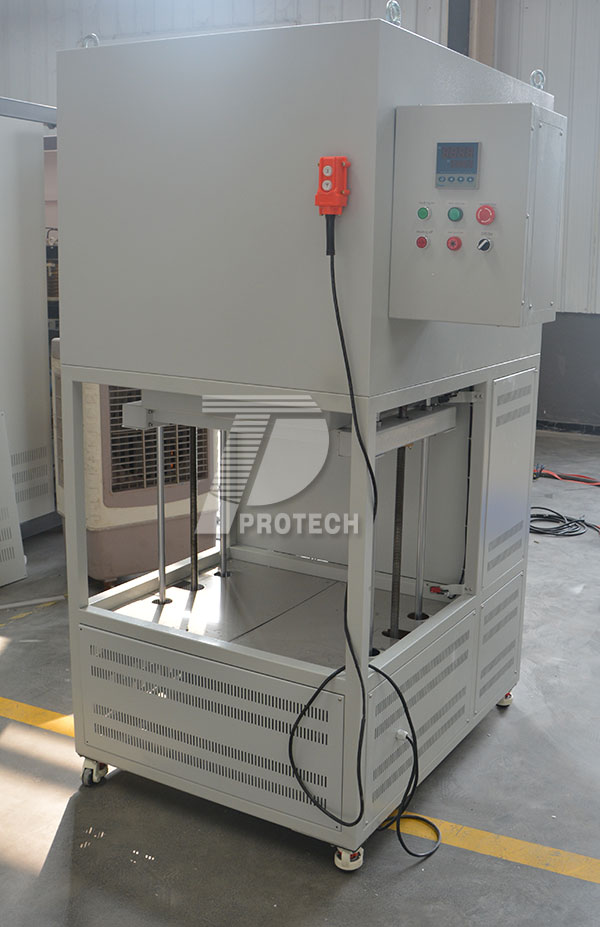The bell shaped lifting high-temperature muffle furnace is a special equipment that combines the design of the lifting furnace door with the function of high-temperature muffle furnace. It achieves material retrieval and placement through vertical lifting of the furnace body or furnace bottom, while providing precise temperature control and stable high-temperature environment. It is widely used in the fields of precision material processing and scientific research experiments. Let’s take a detailed look at the bell type lifting high-temperature muffle furnace below!

Commonly used bell furnace (click on the image to view product details)
1. Core design: Integration of lifting structure and high temperature performance
Lift transmission system
The furnace door is located at the lower part of the furnace body and is driven up/down by a mechanical or hydraulic system (or the furnace door can be raised or lowered separately) to achieve contactless material handling. This design avoids the inconvenience caused by space limitations in traditional side opening furnace doors and is very suitable for handling large, irregular, or fragile samples (such as fiber-reinforced composite materials and precision ceramic parts).
High temperature heating module
Heating element: using resistance wire (≤ 1000 ℃), silicon carbon rod (1000-1500 ℃) or silicon molybdenum rod (1500-1800 ℃), generating radiant heat through current thermal effect, combined with refractory materials such as alumina fiber or mullite lining of the furnace, to achieve efficient insulation and uniform temperature field.
Temperature control: Equipped with a PID intelligent temperature control system, the accuracy can reach ± 1 ℃, supporting multiple programmable heating curves (such as 30 program temperature control), meeting complex process requirements.
Sealing and atmosphere control
The furnace door adopts a double-layer sealing structure (such as ceramic fiber+high-temperature resistant silicone pressure strip), combined with a vacuum pump or gas inlet system, which can achieve inert gas protection (such as nitrogen, argon) or vacuum environment to prevent sample oxidation or contamination.
2. Performance characteristics: a balance between precision, efficiency, and safety
Convenience of operation
The lifting design reduces material handling time by more than 50%, especially suitable for research and development scenarios that require frequent sample replacement (such as lithium battery material calcination).
Some models are equipped with back mirrors or observation windows, which support 360 ° observation of material melting and shrinkage processes without blind spots, improving experimental controllability.
Uniformity of temperature field
By optimizing the furnace structure (such as double-layer shell+air-cooled system) and heating element layout, a more balanced temperature inside the furnace can be achieved, ensuring consistent heating of the sample and reducing the risk of cracking.
safety protection
The surface temperature of the furnace body has a small difference from room temperature, and is equipped with multiple safety mechanisms such as over temperature alarm, leakage protection, and power-off when opening the door.
The emergency stop button and fault self diagnosis function ensure the safety of operators and equipment.
3. Application scenario: Full coverage from industrial production to cutting-edge scientific research
Materials Science Field
Ceramic firing: Provides a stable high-temperature environment (such as 1600 ℃) to ensure a ceramic material density of ≥ 99%, suitable for precision processing of electronic ceramics, bioceramics, and other materials.
Metal heat treatment: By precise temperature control, metal annealing, quenching and other processes are achieved to improve material hardness and toughness (such as increasing the elongation of aviation aluminum alloys).
new energy industry
Calcination of lithium battery materials: Optimize the heating curve and holding time of positive and negative electrode materials (such as ternary materials) to improve battery energy density and cycle life.
Solid state electrolyte synthesis: High temperature solid-state reaction is completed under inert gas protection to avoid performance degradation caused by material contact with air.
Semiconductors and Electronic Components
Wafer oxidation/diffusion: Accurate alignment between the wafer and the furnace is achieved through a lifting sample stage, ensuring uniform temperature field and reducing lattice defects.
Ceramic substrate sintering: In conjunction with a vacuum environment, it meets the bubble free sintering requirements of high-precision electronic components.
Chemical and Refractory Materials
Catalyst carrier calcination: Stable operation under strong acid and alkali conditions, supporting the regulation of carrier pore structure.
High temperature and pressure resistance test: Simulate temperature shocks in actual usage environments to accurately obtain material performance parameters.
4. Example product parameters (taking the 1600 ℃ bell jar lifting furnace as an example)
Maximum working temperature, 1600 ℃ (long-term use temperature ≤ 1550 ℃);
Temperature control accuracy ± 1 ℃ (PID intelligent control);
Heating rate: 0-20 ℃/min (adjustable);
Furnace size: 500 × 500 × 500mm (volume 125L);
Heating element: silicon molybdenum rod (B-type thermocouple);
Sealing: Vacuum environment;
Safety functions: over temperature alarm, leakage protection, power outage when opening the door.
5. Selection suggestions
Process requirement matching
If dealing with easily oxidizable materials (such as titanium alloys), priority should be given to models with vacuum function;
For large-sized samples (such as ceramic discs with a diameter greater than 300mm), it is necessary to confirm the furnace opening size and load-bearing capacity.
Energy consumption and efficiency balance
The lifespan of silicon molybdenum rod heating elements (about 5000 hours) is longer than that of silicon carbon rods (2000 hours), but the cost is higher and suitable for long-term high load operation scenarios.
Scalability
The optional computer control system can achieve remote monitoring and data recording, improving the reproducibility of experiments.

Customized bell shaped lifting high-temperature muffle furnace (click on the picture to view product details)
Overall, the bell type lifting high-temperature muffle furnace has numerous advantages and a wide range of applications. Before choosing, you can communicate with relevant technical personnel about the parameters you want, so that you can customize a bell type lifting high-temperature muffle furnace that is more suitable for your own production or experiment!Click to learn more Customized muffle furnaces! Or click on online customer service to learn more about product information!